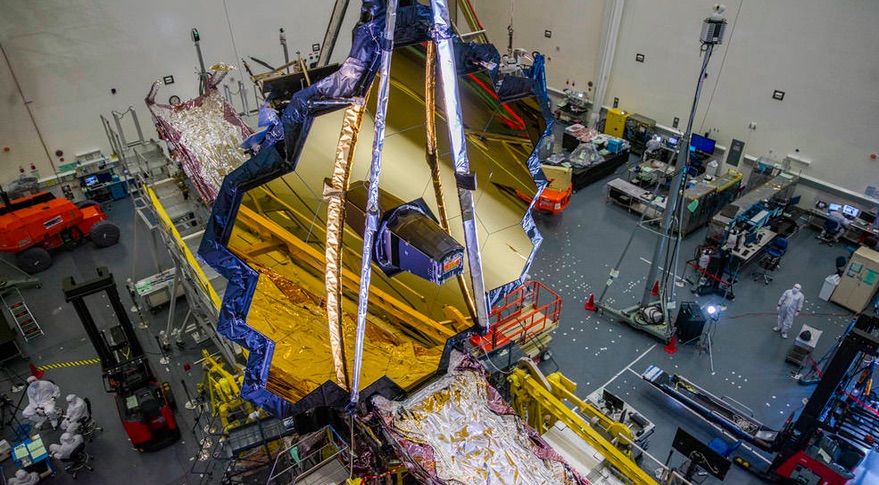WASHINGTON — Several NASA astrophysics missions in various stages of development are likely facing delays because of the coronavirus pandemic, an agency official said.
At a Sept. 21 meeting of the Astronomy and Astrophysics Advisory Committee, Paul Hertz, director of NASA’s astrophysics division, said the agency anticipated a number of missions, big and small, will suffer delays, although it may take time to determine the exact effects on the schedule.
“All of our missions in development are proceeding, however, they are suffering reduced efficiency because of the pandemic,” he said. That includes a reduced pace of work to incorporate social distancing and related measures, as well as travel restrictions. “Disruptions to the supply chain are affecting us now, and that will be a ripple effect that we won’t know the full extent for quite a while.”
NASA’s biggest astrophysics mission, the James Webb Space Telescope, has already seen its launch slip seven months to the end of October 2021 because of pandemic-related issues. Hertz said the mission was sticking to that revised schedule, with acoustics testing of the spacecraft completed and vibration testing now underway.
At the small end of the scale is the Imaging X-ray Polarimetry Explorer (IXPE) spacecraft, an Explorer-class mission that was to launch next May. That launch has now slipped to at least September because of delays in assembly of the spacecraft caused by the closure of the Marshall Space Flight Center for three months due to the pandemic. Hertz said a formal revised launch date for IXPE should come after a review scheduled for October.
Other missions in development may also be delayed, although by how much is not yet clear. That includes the Nancy Grace Roman Space Telescope, NASA’s next flagship astrophysics mission that was previously known as the Wide-Field Infrared Survey Telescope (WFIRST).
“We know there are impacts on Roman, that the critical path is being impacted,” he said. “We haven’t been able to cost them out, and we haven’t made any formal changes in the commitments for Roman.”
The mission passed a confirmation review early this year that set its cost through launch, by 2026, of $3.2 billion, although the agency’s fiscal year 2021 budget request proposed terminating the mission. Hertz said the agency planned to perform an assessment of the cost and schedule progress on the mission at the end of the year, ahead of the mission’s critical design review in 2021.
An Explorer-class mission called Spectro-Photometer for the History of the Universe, Epoch of Reionization and Ices Explorer (SPHEREx), selected by NASA for development in early 2019, could be delayed as well. Work on the mission has slowed down during the pandemic, he said, so a “notional” launch date of 2024 might not hold.
Japan’s X-ray Imaging and Spectroscopy Mission (XRISM), for which NASA is contributing instruments, is also facing a delay, but not entirely because of the pandemic. Hertz said that while the NASA-contributed hardware remains on schedule, a Dewar that holds liquid helium to cool the instruments has developed a leak. NASA personnel have traveled to Japan to assist in troubleshooting the problem, which he said was the first international travel approved by the agency since the onset of the pandemic in March.
That technical issue will delay the launch of XRISM, which was previously scheduled for early 2022, but Hertz said the Japanese space agency JAXA has not yet set a new launch date.
NASA’s operational astrophysics missions, by contrast, have been largely unaffected by the pandemic. Space missions continued normal activities, in part to past efforts to streamline operations for extended missions.
“It turns out that, over the years, the pressure we have put on our missions through our senior reviews to continuously reduce their costs of operations and go to ‘lights-out’ operations,” he said, “has created exactly the right capabilities that we need to be able to carry out science operations remotely during a pandemic.”
NASA’s balloon astronomy program that flies instruments into the stratosphere remains grounded, though, because of the pandemic. The Stratospheric Observatory for Infrared Astronomy (SOFIA) aircraft, grounded in March, resumed flights in mid-August. SOFIA will continue a series of science flights through the end of September, after which it will go to Germany for its regularly scheduled maintenance through the end of the year.
The Chandra X-ray Observatory did suffer a technical problem that suspended observations Aug. 24. Hertz a high-voltage power supply on Chandra’s High Resolution Camera had failed, so controllers switched to a backup system that had not been used since the spacecraft’s launch in 1999. Science observations resumed Sept. 12 with Chandra’s main instrument, an imaging spectrometer, and Hertz said the camera should be ready to resume operations by early October.
